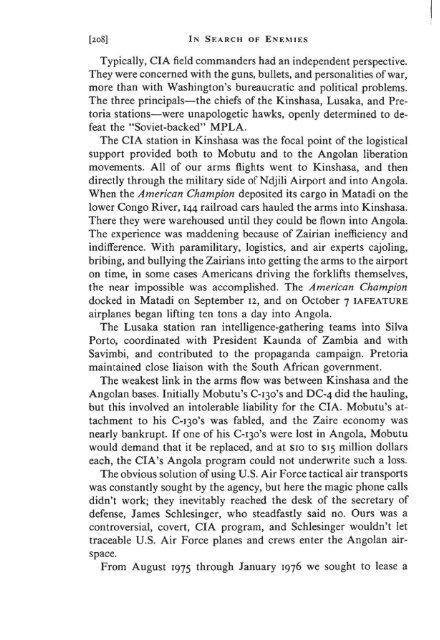In Search of Enemies - A CIA Story - John Stockwell
In Search of Enemies - A CIA Story - John Stockwell
In Search of Enemies - A CIA Story - John Stockwell
Create successful ePaper yourself
Turn your PDF publications into a flip-book with our unique Google optimized e-Paper software.
[208] IN SEARCH OF ENEMIES<br />
Typically, <strong>CIA</strong> field commanders had an independent perspective.<br />
They were concerned with the guns, bullets, and personalities <strong>of</strong> war,<br />
more than with Washington's bureaucratic and political problems.<br />
The three principals-the chiefs <strong>of</strong> the Kinshasa, Lusaka, and Pretoria<br />
stations-were unapologetic hawks, openly determined to defeat<br />
the "Soviet-backed" MPLA.<br />
The <strong>CIA</strong> station in Kinshasa was the focal point <strong>of</strong> the logistical<br />
support provided both to Mobutu and to the Angolan liberation<br />
movements. All <strong>of</strong> our arms flights went to Kinshasa, and then<br />
directly through the military side <strong>of</strong> Ndjili Airport and into Angola.<br />
When the American Champion deposited its cargo in Matadi on the<br />
lower Congo River, 144 railroad cars hauled the arms into Kinshasa.<br />
There they were warehoused until they could be flown into Angola.<br />
The experience was maddening because <strong>of</strong> Zairian inefficiency and<br />
indifference. With paramilitary, logistics, and air experts cajoling,<br />
bribing, and bullying the Zairians into getting the arms to the airport<br />
on time, in some cases Americans driving the forklifts themselves,<br />
the near impossible was accomplished. The American Champion<br />
docked in Matadi on September 12, and on October 7 IAFEATURE<br />
airplanes began lifting ten tons a day into Angola.<br />
The Lusaka station ran intelligence-gathering teams into S~lva<br />
Porto, coordinated with President Kaunda <strong>of</strong> Zambia and with<br />
Savimbi, and contributed to the propaganda campaign. Pretoria<br />
maintained close liaison with the South African government.<br />
The weakest link in the arms fl.ow was between Kinshasa and the<br />
Angolan bases. <strong>In</strong>itially Mobutu's C-13o's and DC-4 did the hauling,<br />
but this involved an intolerable liability for the <strong>CIA</strong>. Mobutu's attachment<br />
to his C-13o's was fabled, and the Zaire economy was<br />
nearly bankrupt. If one <strong>of</strong> his C-13o's were lost in Angola, Mobutu<br />
would demand that it be replaced, and at $10 to s15 million dollars<br />
each, the <strong>CIA</strong>'s Angola program could not underwrite such a loss.<br />
The obvious solution <strong>of</strong> using U.S. Air Force tactical air transports<br />
was constantly sought by the agency, but here the magic phone calls<br />
didn't work; they inevitably reached the desk <strong>of</strong> the secretary <strong>of</strong><br />
defense, James Schlesinger, who steadfastly said no. Ours was a<br />
controversial, covert, <strong>CIA</strong> program, and Schlesinger wouldn't let<br />
traceable U.S. Air Force planes and crews enter the Angolan airspace.<br />
From August 1975 through January 1976 we sought to lease a


